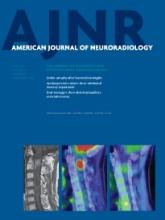We read with interest the article entitled “Detection of Intratumoral Calcification in Oligodendrogliomas by Susceptibility-Weighted MR Imaging”1 and would like to comment on the appearance of calcification on the high-pass-filtered phase images.
The authors reported that the paramagnetic (authors wrote “diamagnetic”) hemorrhagic component of the tumor would cause a negative phase shift and appear as dark signal on the high-pass-filtered phase images, while the diamagnetic (authors wrote “paramagnetic”) intratumoral calcifications would cause an opposite positive phase shift and appear as bright signal on the high-pass-filtered phase images. This description is true, but only in the case of right-handed MR imaging systems, while in left-handed MR imaging systems, the complete opposite signal would be seen: Paramagnetic substances would appear bright, while diamagnetic substances would appear dark.2,3
In Figs 2D and 3D of the above-mentioned article, the high-pass-filtered phase images are those of a left-handed MR imaging system, evident by the bright signal of the veins (paramagnetic deoxyhemoglobin).3
The article showed that high-pass-filtered phase images can depict intratumoral calcification in oligodendrogliomas better than conventional MR images; this finding has been reported before.4 Understanding the contrast appearance of high-pass-filtered phase images on left-handed versus right-handed MR imaging systems would make distinguishing diamagnetic calcification from paramagnetic hemorrhage a much easier task and prevent any possible confusion.
- © 2013 by American Journal of Neuroradiology












